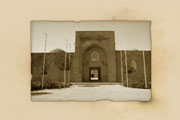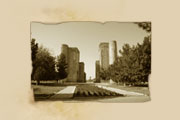
 |
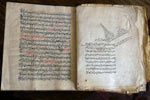

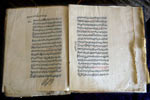


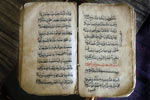
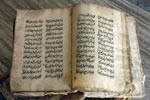
|
Written sources
The written language history and script culture are integral part of State
system, socio-economic, educational life of the past. script culture was formed
during several ages and passed through such periods as “mnemonics”, “material
script”, “pictography”, “ideogram” before alphabet’s appearances with written
letters. For example there are pictography scripts (consisting of pictures) oh
the rock of Suypantosh monument located in Kuruksoy foothills in the Eastern
part of Kashkadarya (the late era of paleolith and mesolite), and ideogram
scripts (symbols with exact and easy image) on the earthenware crockery found in
Podayotoktepa (VIII –VII century B.C.). VIII-VII centuries in the Central Asia
are periods of script culture prosperity, some scientists think that the most
ancient part of the holy Zaratushtra’s book Avesta was written in this period.
The Eastern part of Kashkadarya, Gava Suguda, is described as sogdian Motherland
in this holy book. Though the Central Asian in the early of the 1st millennium
B.C. population knew the Phoenician and then the Aramaic framed by Shamiy nation
in the Front Asia. Such is indeed language in which holy book Avesta was written.
Ancient written language of the Central Asion nations was developed in 3 ways
geneticly. First it was local script formed in VI-V B.C.. This written language
named in science as “hot script” couldn’t compete with Aramaic which was the
state language at that time. The Sogdiya written language appear with increasing
of satrap’s authority of Akhmoniy’s state based on the Aramaic letters. Horezm’s
written language was also based on the Aramaic, 20 letters were taken from there
22 ones. Ancient Bokhtar script was also formed bu the way of Aramai conformity
to Baktrian language. Besides above-listed Sogdiana, Khoresmian, Baktrian,
Greco-Baktrian scripts there were scripts of Maniy, Sureni, Kharoshtkhi,
Barkhmiy, Uigur- Turky and ancient Turky but unfortunatly they were little
studied. There are also ideogram scripts (symbols with exact and easy image) on
the earthenware crockery found in Podayotoktepa in the museum.
The further written language history and script culture of Uzbekistan people is
connected with Arabic character and monuments of ascripts in the Arabic, farcy и
Turkic languages also written in Arabic is a written heritage of uzbek people.
The ofocial Arabic character first was named «Ma’kaliy». Letters were written in
vertical and plate form. The style of Kufiy script was created in VII age in the
town Kufs Ya’rabom ibn Kakhtonom. This script was used in the Koran «The Langar
Koran» which is kept in Katta Langar mosque. This script was used on the wall
decoration of the main buildings of Shakhrisabz. In the complexes of Oksaroy,
Dorulsaodat and Dorultilovat. It was used because the symbols were ias
geometrical rectangle and design. There are exponats on Kufiy script on the
earthenware crockery of Karakhanid period in IX-XI centuries.
Arabic character development became a reason of appearin of new styles in the
early 10 age. Those styles were based on Kufiy style and were of several types:
mukhakkik, raykhani, suls, naskh, tavki’, riko’. After naskh script was widily
used in bookish art, ta’lik was used till 14 century. A lot of manuscrips were
written in naskh and riko’ scripte till nasta’lik script appearance.
In script culture and in iohter spheres began the Renaissance period in Amir
Temur and the Temurids’ epoch. Large libraries were opend in Amir Temur 's
palace where famous all over the world penmen worked. For example it was noticed
in the book «Zafarname” by historian Sharafiddin al Yazdi that Amir Temur's
latter was sent to Pharaoh written by mavlono Abdullokhom Keshi which was of 3
arshine and 70 arshine long rounded with golden water and made in bookish pen
style by mavlono Muhammad». In the Amir Temur and the Temurids’ epoch
calligraphy was led to the top of perfection, this tradion was continued when
ruling of Mirza Shakhrikh in Guerat, Sheraze and other towns. When ruling of
Khusain Baykaro, Alisher Navoi protected this style. Poets made strong
ascendancy in the culture of that time such as Amir Khisrav Dekhlavi (1253-1325)
moved from Shakhrisabz to India, Mirza Abdulkodira Bedila (1644-1721). Who wrote
in the Farcy и Tajik languges. Ayyub Shakhrisabzi ibn Abdulbaraka, Lozimi Keshi,
Najmi Keshi, Khakim Shakhrisabzi, Mir Tabib, Mushtok Shakhrisabzi, Farakh
Shakhrisabzi did in Amir Temur and the Temurids’ epoch. Such penmen as
Darvishmukhammad ibn Dustmuhammad (XVI century), Mir Abdullokh Termizi (XVII
century), Mukhammad Yusuf Makhmud Chappanavis (XIX century), Akhmad Donish (XIX
century), Mukhammad Sharif Samarkandi (XIX century), in Shakhrisabz Mirza
Umbrokiy Shakhrisabzi(Samarkandi) (1878-1957), Fayzullo Ravnaki (1892-1978),
Abdullo Rakhmon Gulshani (1898-1978), Ismoilkhon Shakhrisabzi Fakiri
(1910-1980), Najimiddim Asiri (Najoti) (1917-1853), Salokhiddin Mannon ugli (Solikhi)
(1905-1977) lived in Maverannakhr in XVI-XIX centuries.
|
|
|




